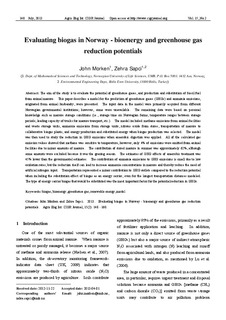| dc.description.abstract | The aim of the study is to evaluate the potential of greenhouse gases, and production and substitution of fossil fuel
from animal manure. This paper describes a model for the prediction of greenhouse gases (GHGs) and ammonia emissions,
originated from animal husbandry, were presented. The input data in the model were primarily acquired from different
Norwegian governmental institutions; however, some were unavailable. The remaining data were based on personal
knowledge such as manure storage conditions (i.e., storage time on Norwegian farms, temperature ranges between storage
periods, loading capacity of trucks for manure transport, etc.). The model included: methane emissions from animal facilities
and waste storage units, ammonia emissions from storage units, nitrous oxide from stores, transportation of manure to
collaborative biogas plants, and energy production and substituted energy when biogas production was selected. The model
was then used to study the reduction in GHG emissions when anaerobic digestion was applied. All of the calculated gas
emission values showed that methane was sensitive to temperature; however, only 4% of emissions were emitted from animal
facilities due to minor amounts of manure. The contribution of stored manure in summer was approximately 62%, although
some amounts were excluded because it was the grazing season. The estimates of GHG effects of anaerobic treatment was
45% lower than the governmental estimates. The contribution of ammonia emissions to GHG emissions is small due to low
oxidation rates, but the reduction itself can lead to increase ammonia concentrations in manure and thereby reduce the need of
artificial nitrogen input. Transportation represented a minor contribution to GHG outlets compared to the reduction potential
when including the substitution effect of biogas as an energy carrier, even for the longest transportation distances modeled.
The type of energy carrier biogas that would be substituted was the most important factor for the potential reduction in GHGs. | nb_NO |

